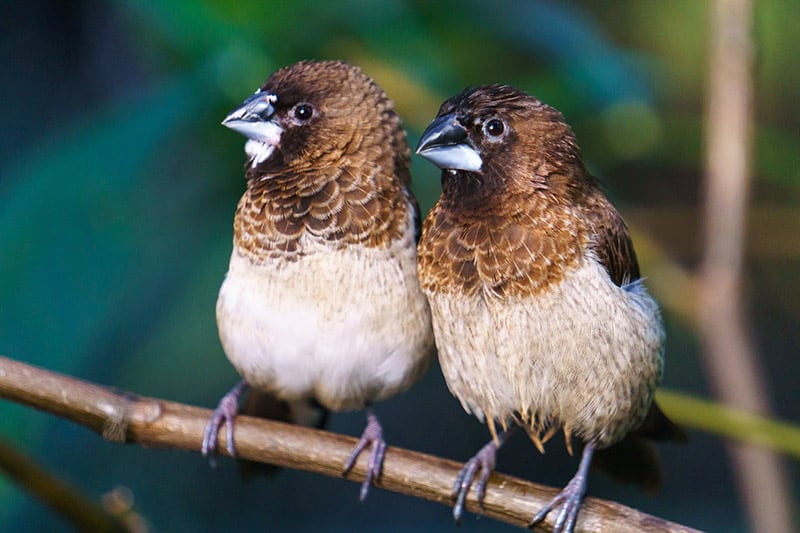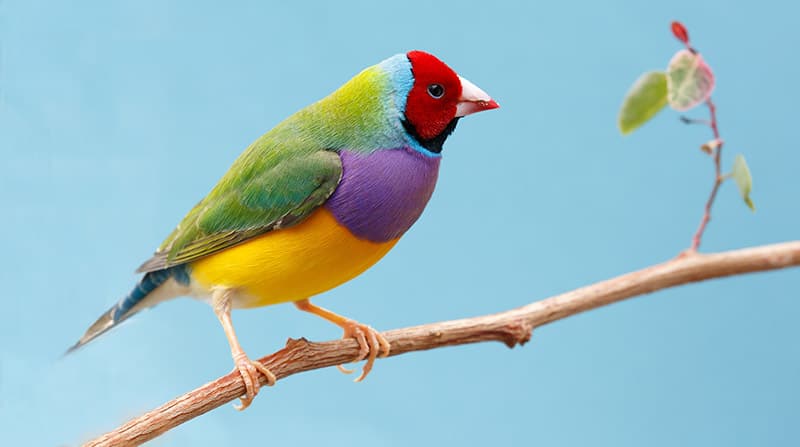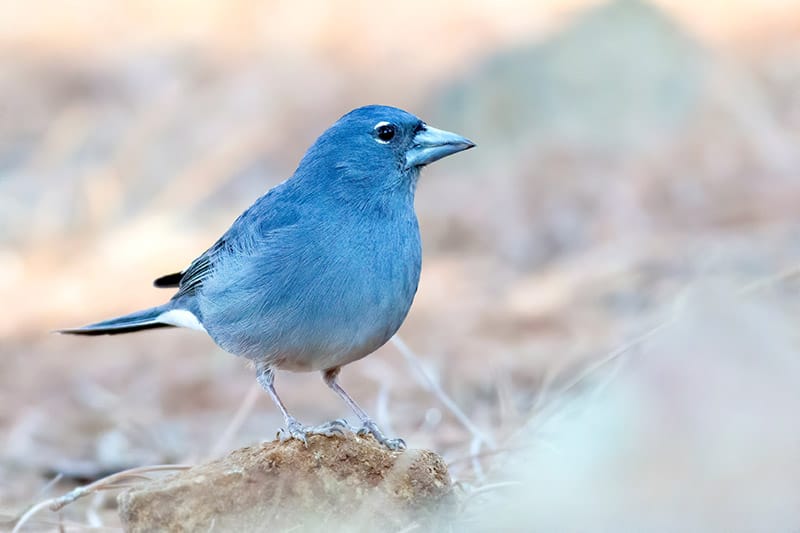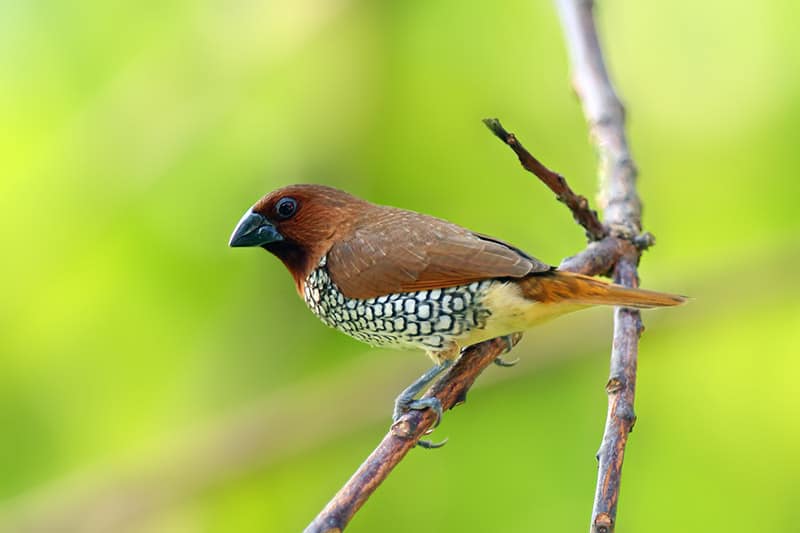Pet finches make lively, interesting, cheerful companions. In today’s busy world a finch bird is an ideal pet for many homes. Finches come in a wide variety of colors, patterns, and personalities.
Most finches are easy to care for, active. entertaining, and hardy. They are quiet and many species can live in a fairly small area, so they make a good apartment pet. They are also less costly to purchase than many parrots and softbilled birds.
These lovely charmers are undemanding, so adding them to your home doesn’t add an unwelcome burden to a busy schedule. Unlike a parrot, that may pout if you are unable to play with it every day, pet finches prefer to play among themselves.
You can just sit back, relax and enjoy their antics. Of course being ‘bird-oriented’ rather than ‘people-oriented’, they are unlikely to become finger tame birds.
- To learn more about the “Family” of your pet finch visit: Finch Families: Finch Family Information for Different Types of Finch
Distribution
Wild finches are found throughout the world. Today there are many finch breeders, so many types of finches are now bred in captivity.
Description
There is such a wide variety of finches! They vary in size from under 3″ up to 8″ (7.5-20 cm) in length. Their plumage can be very colorful, depending on the species. Finches are mostly quiet birds, there are some that have a song, and most are very active. The average life span of most finches is between 5 and 10 years, though there have been some finches known to have lived for up to 27 years! There are hundreds finch species! There are many types of finches, many are wild finches, but a wide variety can be found in the pet industry. All finches, both wild finches and pet finches, belong to one of four families.
- Fringillidae:
The Fringillidae family of finches are known as the ‘True Finches’. This finch family includes some of the most popular cage and aviary finches. There are several subfamilies and 125+ species.Estrildidae, Ploceidae, and Passeridae.The types of finches that are commonly available, sorted by their families, include: - Estrildidae:
The Estrildidae family of finches includes the grass finches, parrot finches, waxbills, munias, and the mannikins or nuns. This finch family contains over 133 finch species. Some of the finch varieties in this finch family are: - Ploceidae:
The Ploceidae family of finches includes the weavers and whydahs. There are several subfamilies and 156+ finch species. Some of the finch varieties in this family are: - Passeridae:
The Passeridae family of finches contains over 32 finch species.
A wide variety of finches can be found in the pet industry and from finch breeders. A list of finches that are commonly available include:
- African Silverbill Finch
- Blue-capped Cordon Bleu Finch
- Blue-faced Parrot Finch
- Crimson-crowned Weaver
- Diamond Sparrow
- Lady Gouldian Finch
- Orange Weaver
- Owl Finch
- Paradise Whydah
- Pintail Whydah
- Red-faced Star Finch
- Red-headed Parrot Finch
- Society Finch
- Spice Finch
- Strawberry Finch
- Zebra Finch

Care and feeding
Fresh food and water must be provided daily. Finches are easy to feed.
- Bird Food:
Finch seed is the everyday food for a finch bird. Seed mixes designed for finches are readily available. A single finch will eat about one teaspoon of seed a day and will rarely overeat. However, they may need to eat a bit more when the weather is cold or during their moult. - Supplements:
Supplements are very important and can be put in an extra dish and rotated for variety.- Sprouts and Millet:
Sprouted seed and spray millet are especially good for all finches. - Protein:
For proteins, you can offer supplements such as egg food, milk-soaked whole wheat bread, insects such as meal worms and fruit flies, mynah bird pellets, and even a bit of dry dog food. - Vitamins:
Cod liver oil will provide Vitamin D to birds who get no direct sunlight. - Grit:
Grit with charcoal is essential to aid in digestion and it contains valuable minerals and trace elements. Grit should be provided in a special cup or sprinkled over the bottom of the cage floor. - Calcium:
Provide a cuttlebone because the calcium it provides will give your bird a firm beak, strong eggshells when breeding, and will help prevent egg binding. The lime in the cuttlebone also aids in digestion. - Occasional Treat Supplements:
Supplements to offer sparingly include greens such as: spinach, chickweed, carrot tops, watercress, dandelions, and leaf lettuce, as well as an occasional bit of apple or pear. Finch treats of seed with honey, fruits and vegetables are fun for your bird too, as well as nutritious!
- Sprouts and Millet:
- Water:
Give your finch fresh drinking water every day. You can also add soluble vitamins and minerals to the water. - Bird Baths:
Give your finch a bath at least once a week and daily during the summer by placing a dish on the bottom of the cage. A bath with an enclosure will help to keep the water splashing to a minimum. Bathing is very important to finches during moulting and breeding. - Bird Grooming:
Their nails will occasionally need to be trimmed, but be careful never to clip into the vein as the bird can quickly bleed to death. Bird nail trimmers and styptic powder to stop the bleeding are available at pet shops.
Housing
- Bird Cages:
Finches get their exercise by flying so it is recommended that they have at least a 12″ x 18″ (30 cm x 45 cm) cage per pair. Finches need room for short flights.
Provide finch feeders for food and water, and dishes for treats and grit as well as an area for a bath. Finches will appreciate a nest box to sleep in. You can attach a “bird protector” disk to the side of the cage to prevent mites. Place paper on the cage bottom that can be sprinkled with grit, or use a grit paper. - Bird Perch:
Provide two or three good softwood perches about 3/8″ to 3/4″ in diameter.Tree branches of a similar size also make good perches and will help to wear the claws down naturally. - Where to Place Finch Cages:
Place the finch cage on a stand or hang it from a wall bracket at eye level or at about 6 feet off the floor in a spot that has good light, is well ventilated, and free from drafts. Place the cage close to at least one wall to enhance a feeling of security.
Keep the cage away from doors and windows where direct exposure to sunlight can make it overly warm. Average daytime temperatures can range from between 60 degrees to 70 degrees Fahrenheit with nighttime temperatures down to 40 degrees Fahrenheit.
The finch cage should be covered at night to prevent drafts and disturbances. - Aviary:
A roomy indoor aviary, a bird room, or an outdoor aviary (depending on your area) are all good choices. The aviary needs plenty of light and fresh air. The outdoor aviary needs to have a protected shelter that can be heated and cooled where necessary and a flight made with about a 3/8″ wire mesh, anything larger will let in mice.

Maintenance
Although finches require very little time, a clean environment as well as fresh food and water daily is a must to prevent disease and illness. The basic cage care includes daily cleaning of the water and food dishes. Every two to three days change the paper on the bottom of the cage and sprinkle it with about 1/8″ of fresh grit. Weekly wash and dry the entire cage, including the perches.
Social Behaviors
Most finches are very social with good personalities. They will not harm children, visitors, or other pets. Finches are quite friendly and can easily be housed in a spacious cage with other finches and other hardbills. However, larger species may be aggressive to smaller species.
All mixed groups should be watched for bullying and fighting. Don’t overcrowd as this may cause feather picking. It is not recommended to house finches with parakeets, lovebirds, or other hookbills that tend to be more aggressive birds by nature.
Handling/Training
Finches are simply enjoyed for their busy antics, plumage, and some for their song. Most finches will not be handleable, though there are a few finches species that with time and patience can be finger tamed.
When you need to handle your finch for such things as trimming its nails, place your palm on it’s back and wrap your fingers around the bird with your thumb and forefinger on either side of it’s head. Finches rarely bite, and even if they do, they do not have a harmful or dangerous bite.
Activities
Finches must be able to move around and it is important to their health and well-being that they be able to fly from perch to perch. Keep the cage accessories to a minimum to allow free movement. A single toy, mirror, or branch will be plenty and you can change them around periodically to provide variety. Toys that are safe for parakeets are safe for finches.
In the wild, some finches love to roll in dew-dampened grasses for a bath. You can give your pet a treat by occasionally putting in damp dandelion leaves or grasses in the bottom of the cage for a few hours. An enclosed bird bath put in the cage a couple of times a week will also provide a fun bath for your pet. Just do not let your pet get cold!

Breeding/Reproduction
Some finches are fairly easy to breed, such as the popular Zebra Finch and the Society Finch. These two finches will even help to rear the young of other finches. Many finches take more finesse, and some have not yet been bred successfully in captivity.
- Breeding Finches:
Not all finches breed at the same age. Generally, the female should be at least one year old and the male should not be over five years old, though there is a rule of thumb that all finches should be at least 8 months old before being bred. Both males and female must be very well-fed and healthy.
Additional supplements, proteins, calcium, and vitamins A and D are necessary. You should supplement their diet as each species needs. Some will need extra bits of niger seed, spinach, lettuce and dandelion leaves, while others will need an insectivore diet. A bit of olive oil or wheat germ oil on their egg biscuit can help to prevent constipation and egg binding in the female. - Sexing Finches:
Sexes in many species differ in appearance while others look alike and can only be sexed by the behavior or song of the male. - Breeding Environment:
Each finch species has a suitable environment for successful breeding. Some finch breeders will do best as a single pair in a breeding box, while others finch breeders need a large aviary with many other birds around.
Breeding season begins with the arrival of spring. Usually the female builds the next, but again this can differ according to species. Nest types vary with the species as well. Many will use an open cup-shaped nest, but some prefer a nest box or an enclosed grass type or wicker finch nest. Provide a variety and let each pair decide.
For some types of finch breeders, again depending upon the species, you can place a layer of soft wood shavings, corn cob bedding, or nesting material in the nest. For others provide plenty of nesting materials such as grasses, feathers, or commercially prepared finch nesting material in the cage or aviary. - Egg Laying and Hatchlings:
Generally the female will lay an egg a day. Some species will lay only 2 while another can lay up to 10 eggs. The eggs will hatch on in 12 to 16 days, the young will leave the nest in about three weeks, with weaning taking up to another month.
Do not let a pair breed too much or they will start to produce weak babies!
Potential Problems
Finches are very hardy birds and almost all illnesses can be traced to improper diet, dirty cages, and drafts. A balanced diet and plenty of exercise will prevent most finch illnesses. Know your bird and watch for real drastic changes as indications of illness.
Some signs of illness to be aware of are sitting with its eyes closed, feathers that are ruffled, lack of appetite, irregular breathing, keeping its head tucked under its wing, and acting feeble or run down.
Some of the common illnesses and injuries your finch could contract are broken wings or legs, cuts and open wounds, overgrown beaks and nails, ingrown feathers, feather picking, confinement cramps in the legs from a cage that is too small, weight loss, heat stroke, shock, concussion, egg binding, diarrhea, mites, colds, baldness, scaly legs, sore eyes, tumors, loss of song, constipation, and diarrhea.
Often the best remedy is heat. Isolate the bird in a hospital cage where you cover all but the front of the cage and add a light bulb or heating pad to keep the interior of the cage at a constant temperature of 85 degrees Fahrenheit. Remove all perches and put food and water dishes on the floor. If you don’t see improvements within a few hours, take the bird to an avian veterinarian for diagnosis and treatment.

Availability
Many types of finches are readily available and fairly inexpensive little birds. Finches for sale will vary in price based on availability and type. For example, Australian finches are not imported, so they are generally more expensive. Young birds that have completed their first moult are easiest to get in the fall just before the end of the breeding season.
Featured Image Credit: Lance Reis, Unsplash
